
Document-Based Argument Writing: Immigration from the Middle East
This is an argument-centered writing assessment designed to develop students’ critical thinking and writing skills, in an in-class and on-demand setting. Both because of the college-directed rigor of the preparatory work that students will be immersed in, and because of the conditions under which students will be writing, this assessment is also highly aligned with the new SAT exam, so it is an authentic, properly embedded and seamless part of an instructional strategy that has raising students’ college exam scores as one of its objectives. And finally it is document-based, so it parallels the kind of AP Exam writing that many students will be striving to master.
Issue: The United States should significantly restrict immigration from the Middle Eastern due to the possibility of terrorism.
Overview
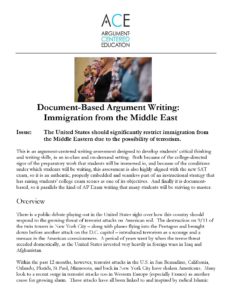
There is a public debate playing out in the United States right over how this country should respond to the growing threat of terrorist attacks on American soil. The destruction on 9/11 of the twin towers in New York City – along with planes flying into the Pentagon and brought down before another attack on the D.C. capitol – introduced terrorism as a scourge and a menace in the American consciousness. A period of years went by when the terror threat receded domestically, as the United States invested very heavily in foreign wars in Iraq and Afghanistan.
Within the past 12 months, however, terrorist attacks in the U.S. in San Bernadino, California, Orlando, Florida, St Paul, Minnesota, and back in New York City have shaken Americans. Many look to a recent surge in terrorist attacks too in Western Europe (especially France) as another cause for growing alarm. These attacks have all been linked to and inspired by radical Islamic extremists, most especially the group ISIS (Islamic State of Iraq and Syria). ISIS is a barbaric group – famous for its production and dissemination of gruesome videos of beheadings and burnings and drownings of its innocent victims – which seeks to impose a medieval, fascistic Islamic government over first the Middle East and then the world. ISIS has shown itself to be adept at using the internet to recruit and radicalize followers, and is proving to be a difficult enemy for the American military and American intelligence services to take on.
The 2016 election has put front and center the question of whether and how immigration policy intersects with strategies to combat terrorism, especially terrorism carried out here. Specifically, conservatives (in this instance led by Republican presidential candidate Donald Trump) have been promoting tougher restrictions on immigration from the Middle East, countries which are identified or associated with the bases of ISIS and other radical Islamic groups. Trump has even called for a temporary ban on all immigration from these countries, so as to reduce the chance that we will be importing an increased threat of terror, and he has campaigned against Democratic nominee Hilary Clinton’s position that the U.S. should allow more refugees from the very bloody Syrian civil war to immigrate here. Clinton and liberals have countered that such restrictions wouldn’t be effective in reducing the actual threat of terrorism (for a variety of reasons) and that immigration restrictions are contradictory to our democratic values and counter-productive because they foster the view held by many in the Middle East that the U.S. is anti-Muslim.
In this argument-centered project, students will enter the fray of this current and broiling controversy by analyzing the arguments and evidence on both sides, and then writing an argument essay in which they present and support their own views.
Method and Procedure
(1)
The issue should be introduced, and a teacher-led discussion should identify and define key terms and vocabulary, along with the positions held on both sides of the debate.
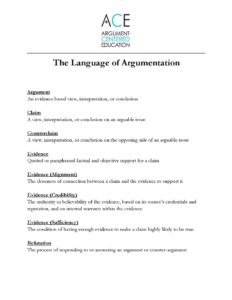
(2)
The Media List should be distributed. Students should be assigned 2 – 3 entries from the list, so that all entries are covered. They should be given an opportunity to study their entries, and then summarize the position, arguments for that position, and backing for those arguments in the piece.
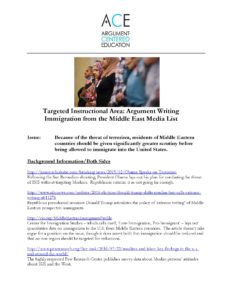
(3)
The teacher should lead an argument-based workshop in which each student presents on an entry in the Media List. Presentations should be very concise, focused on summary, with a short evaluation of the strength of the argumentation in the piece. The teacher should facilitate discussion of the engagement between articles that disagree with or contradict each other. Desks should be arranged in a large circle for this argument-based workshop, to encourage democratic and robust exchange.
(4)
Following the discussion the teacher should chart out the argumentative claims made for each side by the students in the discussion, representing entries in the Media List. The charting should also include at least one counter-argument that the other side could make against each of the claims. In effect, the process here is creating two large T-charts. The teacher should tell the students to consider how a writer would refute each of the counter-arguments listed, though that work shouldn’t be done explicitly in the discussion, nor should the refutation work be charted or tracked out.
(5)
Students should be given the Six Paragraph Argument Essay Outline and Argument and Refutation Builders. They should use these on the days of their in-class, on-demand writing to organize their thinking, assemble their evidence, build their arguments, and prepare their essay. The teacher should review how each of these documents can be most effectively used.
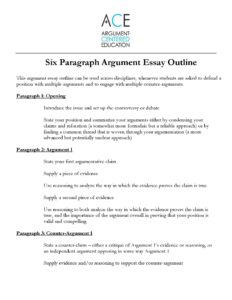


(6)
Students are now ready for an in-class, on-demand writing assessment. The assessment will take two days. On the first day, students should receive the set of textual excerpts on the issue. They should be told that they will be writing an argument essay that will take a position on the issue on immigration from the Middle East. They should be told that their essay should make two arguments to support its position, and that each argument should refer to two of the sources from the textual excerpts document. They should also include two counter-arguments to their position, which they should refute. Each counter-argument should use one source, and refutation of each counter-argument should draw on one source, too.

(7)
At the end of the second day, students should submit their argument essays. Students who finish early should be given a pre-reading assignment for the next unit, to help them get ahead there. The essays should be assessed using the Argument-Centered Education Writing Assessment and Form, which can be adapted to include, for instance, mechanics/grammar or style/use of language.
(8)
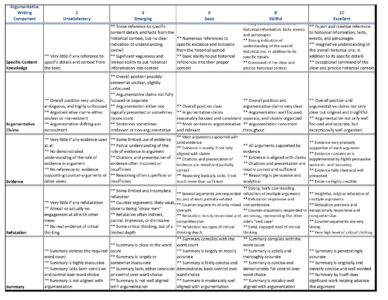
Students should be given an opportunity to revise their essay after they have been returned, with feedback rooted in the assessment form. The instructor should consider keeping as a permanent grade the higher of the two ratings on each assessed item, to encourage students to undertake a revision of their work.

